Bus signal priority is of great significance to improving bus operating efficiency.Current priority methods seldom consider left turns; however, some problems cannot be ignored for left-turning buses.When a bus stop is located upstream of an intersection, left-turning buses stopping at the station always experience difficulties in maneuvering to inner left-turn lanes.More specifically, an upstream bus stop is located in a curb lane, and buses have to merge across multiple lanes to reach a left-turn bay.To solve the merging problem, approaches can be considered, including constructing double left-turn lanes(DLTLs)at intersections.However, left-turning buses still suffer from the difficulty of merging into queuing left-turning cars, which often queue upstream of bus stops during peak hours.To solve this problem, setting up a dedicated bus lane(DBL)for left-turning buses can be considered.In addition, pre-signals can be applied to provide priorities for left-turning buses.
In the present study, transit signal priority(TSP), DBLs, and intermittent bus lanes(IBLs)have been used to provide bus priorities.By adjusting traffic signal plans based on bus arrivals, the delay of buses can be reduced[1].A DBL can be combined with TSP to improve its advantage, but it is only suitable for light volumes of cars because it removes one lane from conventional lanes[2].Viegas et al.[3] proposed the use of IBLs, where cars are forbidden to use lanes downstream of advancing buses.However, when there is no bus arriving, cars using such lanes could increase discharges from the arterial[4].
In addition, as a common bus priority method, pre-signals have been widely used in urban road intersections.There are two types of pre-signals: whole pre-signal and local pre-signal.In a whole pre-signal, all lanes should be set with a pre-signal.To accurately evaluate a whole pre-signal, He et al.[5] proved that bus priorities with pre-signals could improve the intersection capacity.Follow-up studies gradually focused on the control model optimization of pre-signals and the solution method of related parameters[6-10].To meet the diverse traffic demand of intersections, local pre-signals were proposed.In local pre-signals, only one or several lanes are set with pre-signals.In this case, bus priorities can be provided without affecting other movements.A local pre-signal is usually combined with a complex, unconventional design, such as a contraflow left-turn design[11].
However, the two methods will increase the delay of non-priority vehicles and cause waste of space resources at intersections when the proportion of left-turning buses is low.Hence, in this study, a left-turning bus lane is set upstream of the adjacent lane of a left-turn lane, which is controlled by a pre-signal.The downstream of the pre-signal is a variable lane in which buses and non-priority vehicles are allowed to travel simultaneously.The aforementioned approach can save the lane-changing time for left-turning buses.Moreover, the non-priority through vehicles can enter the variable lane, which would minimize the increased delay of non-priority vehicles.
1 Design Concept of VBAL
The intersection implementing the variable bus approach lane(VBAL)scheme shall meet the following conditions:
1)There shall be at least three or more lanes at the approach.
2)A sufficient distance shall be reserved between the stop line and the upstream bus stop.
3)The saturation of the intersection should be less than 0.9.
4)There should be a relatively stable number of left-turning buses arriving in each cycle.
1.1 Geometric and phase design
The geometric design of the VBAL is shown in Fig.1(a), while a reference design for a pre-signal and placard is shown in Fig.1(b).The variable lane is located in the zigzag marking section, which can be used by through vehicles and left-turning buses at different times.The shadow area upstream is a dedicated waiting area for left-turning buses.The section between the two areas is a lane-changing section for non-priority vehicles.
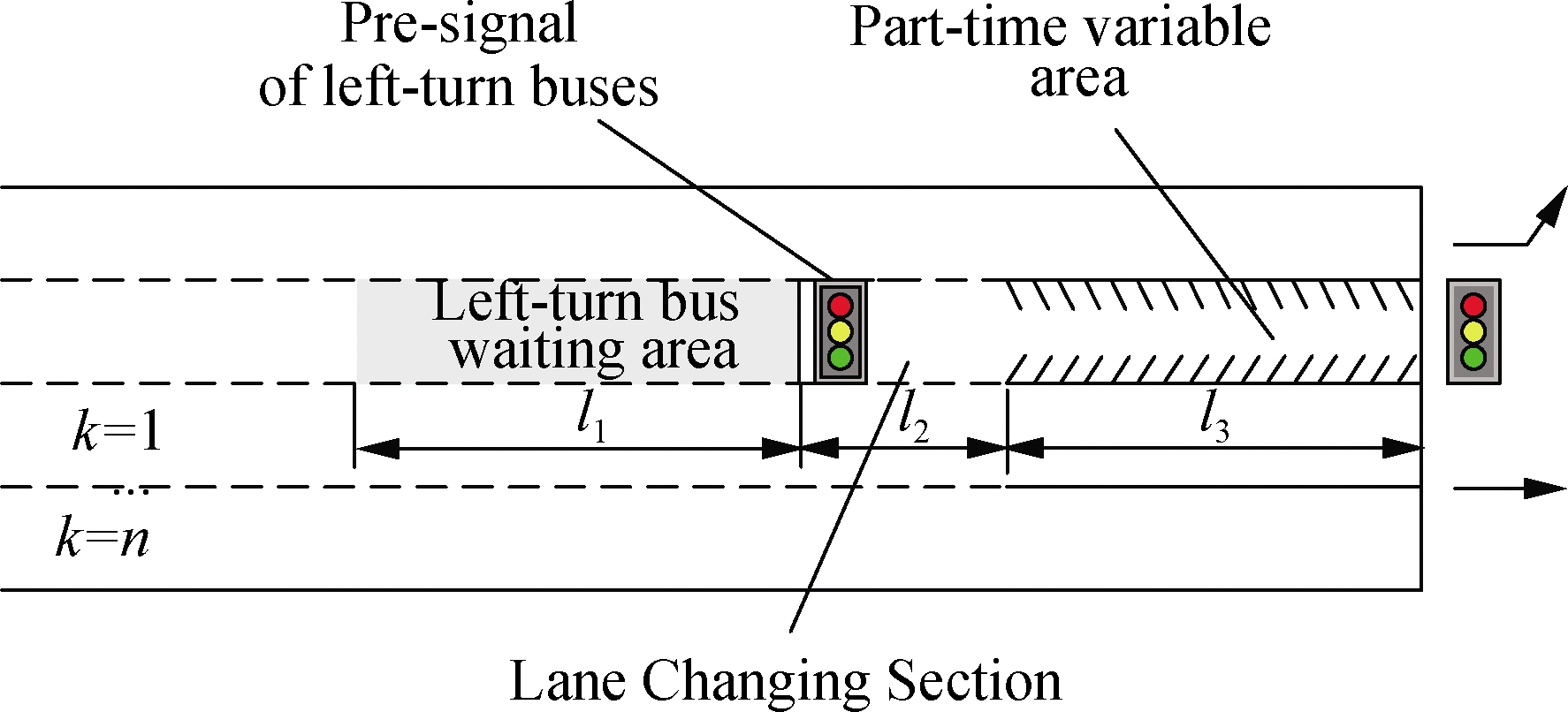
(a)
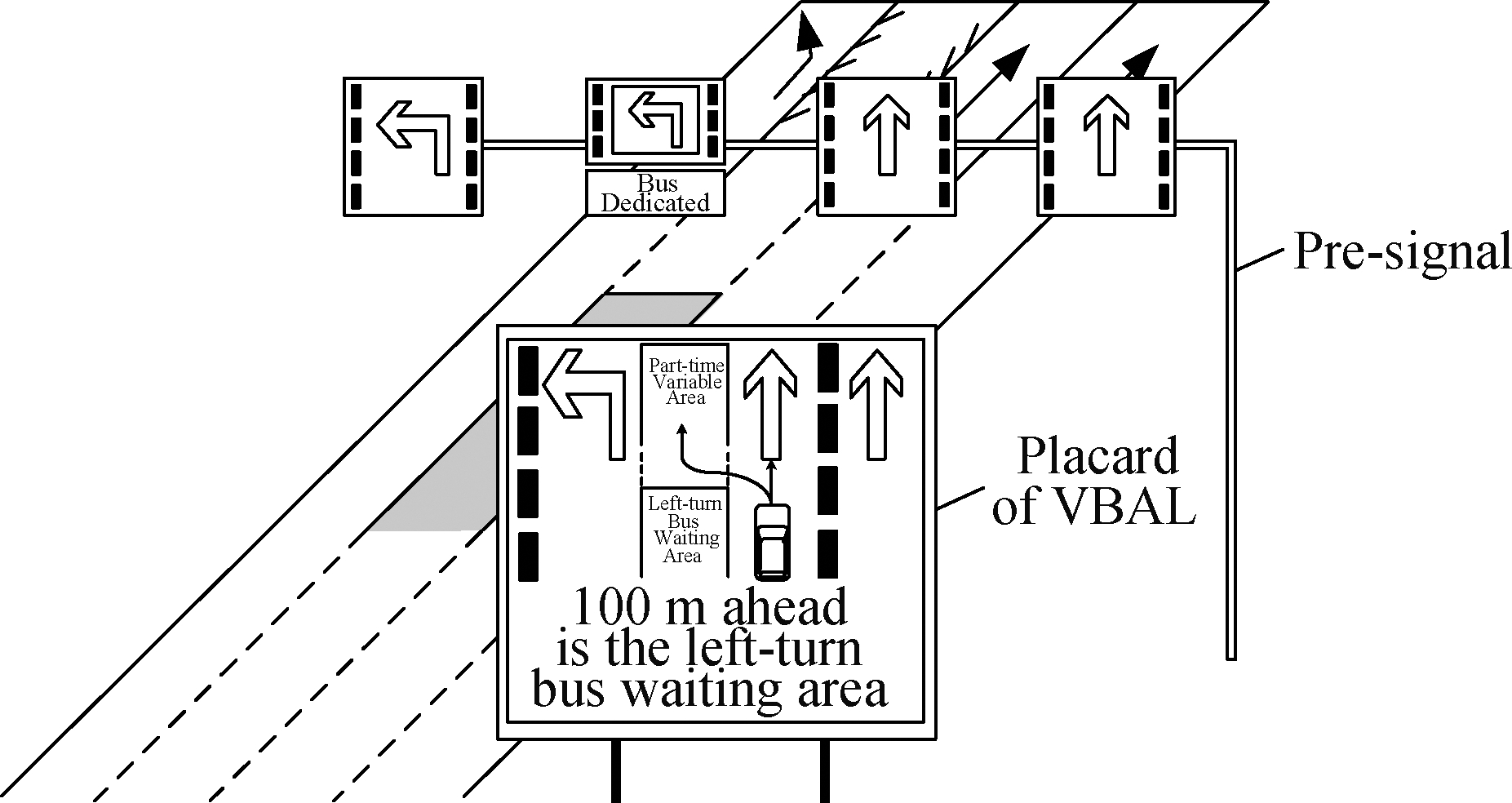
(b)
Fig.1 Layout of the VBAL.(a)Geometric design;(b)Reference design for a pre-signal and placard
Three common phases,namely, four-step phase, single-approach-released-in-turn(SARIT)phase, and overlapping phase, will be discussed in this section.For the convenience of description, traffic methods are explained as follows in the case of the main signal being red, through green, left-turn green, and through-left green.
1)Queue distribution.Left-turning cars wait in the left-turn lane.Left-turning buses queue on the bus lane, and through vehicles wait on the variable or through lanes(see Fig.2(a)).
2)The main signal is through green.In stage 1, the through vehicles pass the intersection from a variable lane or through lanes.Left-turning cars and buses queue up on the left-turn lane and waiting area, respectively(see Fig.2(b)).In stage 2, waiting left-turning buses are allowed to enter the variable lane ahead of time(see Fig.2(c)).
3)The main signal is left-turn green.In stage 1, left-turning buses and cars would be released(see Fig.2(d)).In stage 2, after all the waiting left-turning buses are released, left-turning cars are allowed to enter the inner left-turn lane or variable area(see Fig.2(e)).
4)The main signal is through-left green.In stage 1, left-turning buses pass the intersection through a variable area(see Fig.2(f)).In stage 2, through and left-turning vehicles could be allowed to use the variable area to pass the intersection(see Fig.2(g)).
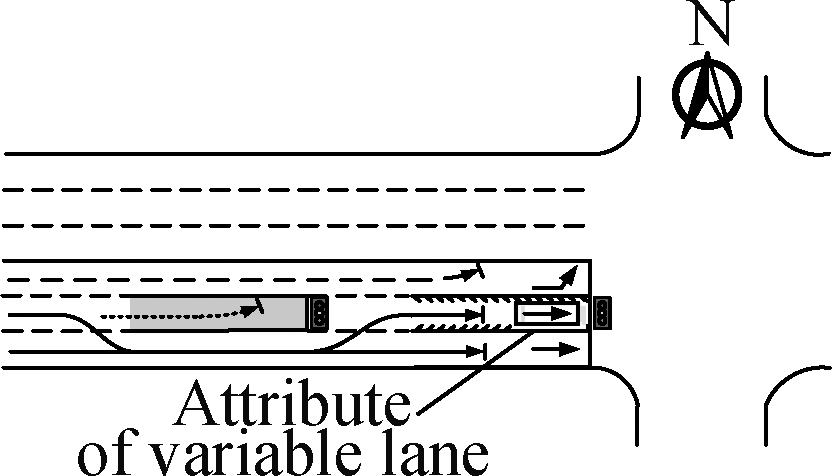
(a)
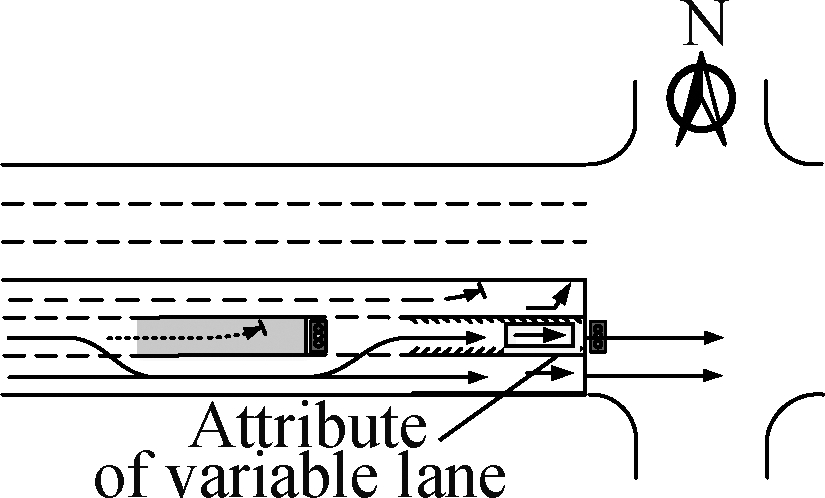
(b)
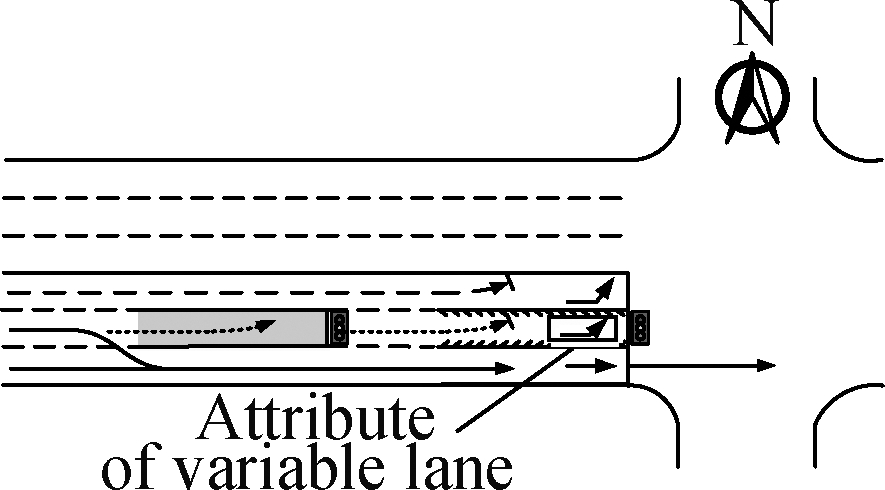
(c)
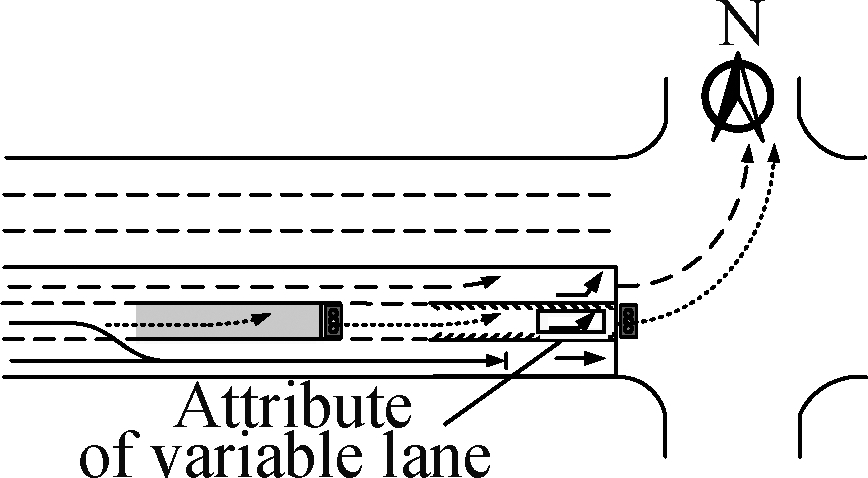
(d)
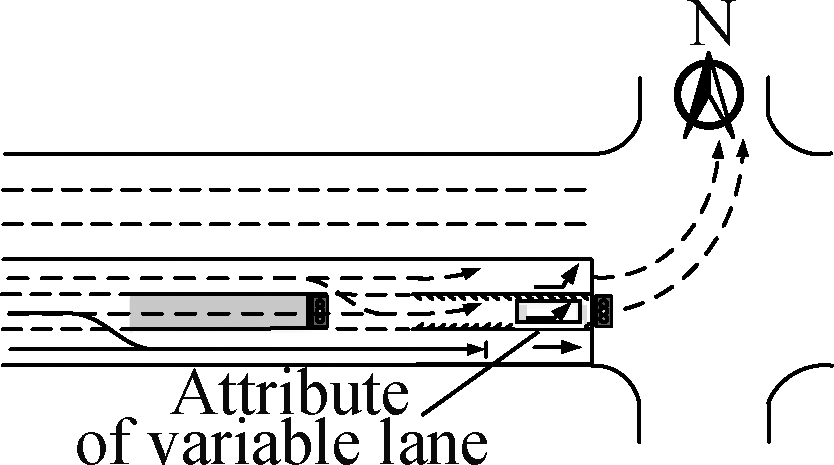
(e)
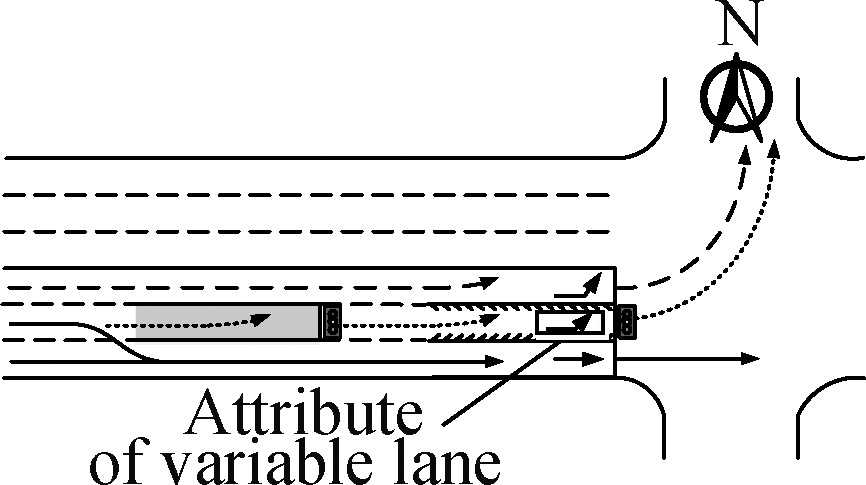
(f)

(g)
![]()
Fig.2 Traffic method of the VBAL scheme under different main signals.(a)Case 1;(b)Case 2;(c)Case 3;(d)Case 4;(e)Case 5;(f)Case 6;(g)Case 7
As discussed above, the traffic methods under the three phases can be obtained by recombining the above situations.In the four-step phase, the release process of the vehicle is(a)→(b)→(c)→(d)→(e).In the case of SARIT, the process is(a)→(f)→(g).In the overlapping phase, the process is(a)→(b)→(f)→(g)(see Tab.1).In addition, the pre-signal cannot turn green in advance in the SARIT phase because through vehicles would queue on the variable lane, which leads to the loss of priority for left-turning buses.Therefore, whether the SARIT phase can be applied to provide priorities for left-turning buses has great uncertainties.
Tab.1 Steps for vehicle release in the VBAL scheme under different phases

PhaseSteps for vehicles releasedFour-step phase(a)→(b)→(c)→(d)→(e)SARIT(a)→(f)→(g)Overlapping phase(a)→(b)→(f)→(g)
1.2 Calculation model of control parameters
The green time of a pre-signal consists of the green time starting in advance g1 and green duration g3.Left-turning buses can reach the stop line of the main signal within g1, and the stranding phenomenon is also avoided.
(1)
g3=g2-g1
(2)
where l3 and l2 denote the length of the variable lane and lane changing section, m, respectively; v is the average speed of buses, m/s; L is the lost time of vehicle starting, s; and g2 is the left-turn green time of the main signal, s.
The geometric parameters of the VBAL depend on l1, l2, and l3, where l3 is equal to the approach lanes, and l1 should meet the maximum queuing distance required for left-turning buses.Suppose that the number of left-turning buses arriving and departing in each signal period is a and b, respectively.Then, the probability of α left-turning buses queuing in the waiting area, Pα, can be given by[12]
(3)
The maximum number of queuing buses M can be obtained by
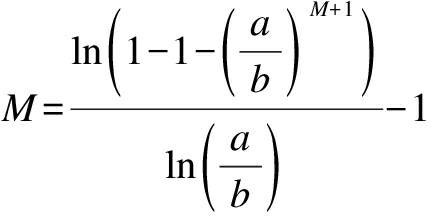
(4)
l1 and l2 are given by [12]
l1=Mlb+(M-1)l
(5)
(6)
where lb denotes the average length of buses, m; l represents the safe stopping distance of buses, m; v is the speed of cars, m/s; and θd is the desired heading angle of cars.
2 Person-Based Delay Model
2.1 Four-phase
Fig.3 presents the cumulative curves under the VBAL and SLTL schemes.As shown in Fig.3(a), the average reduction of the left-turning bus delay under the VBAL scheme, ![]() can be calculated as
can be calculated as
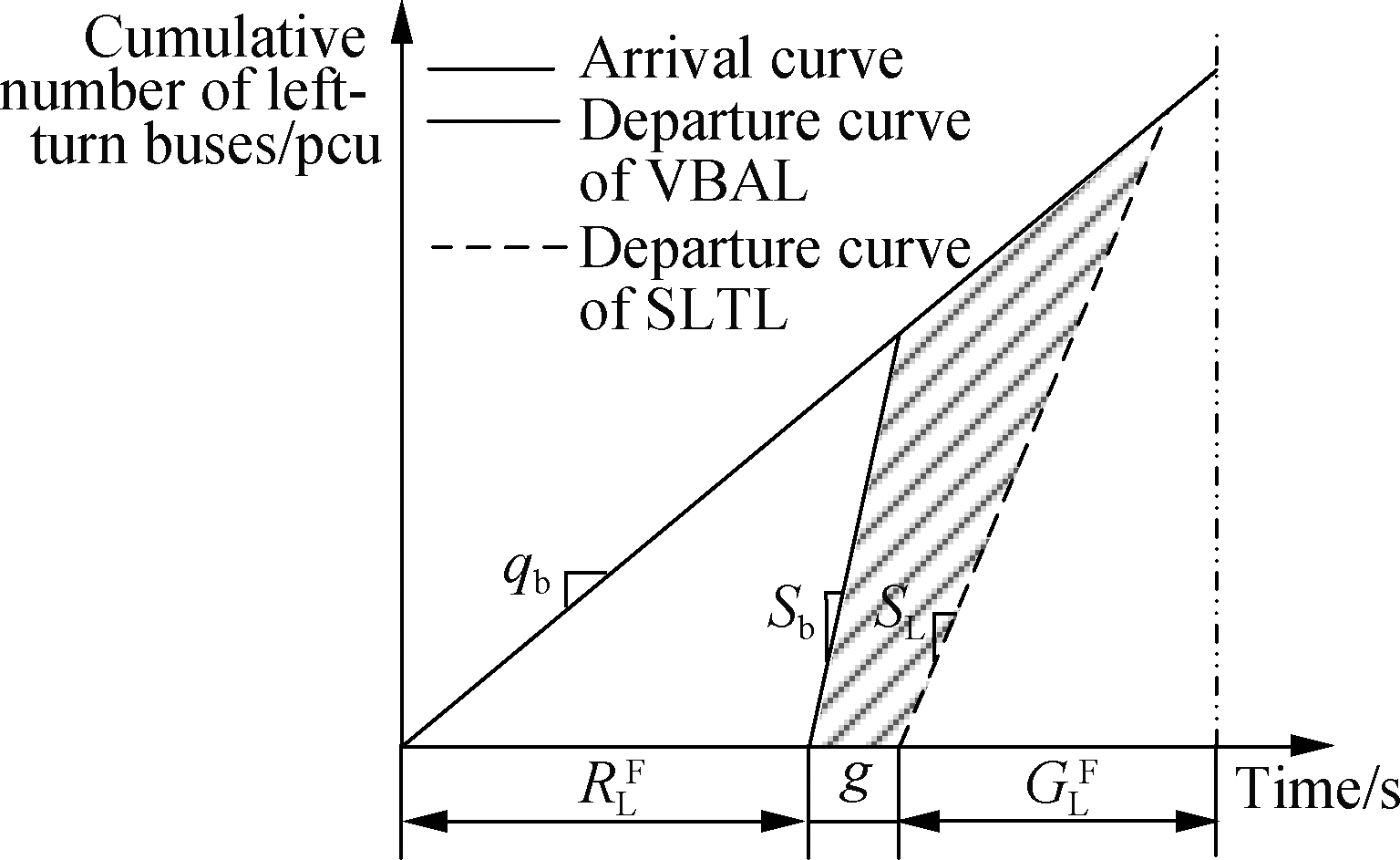
(a)
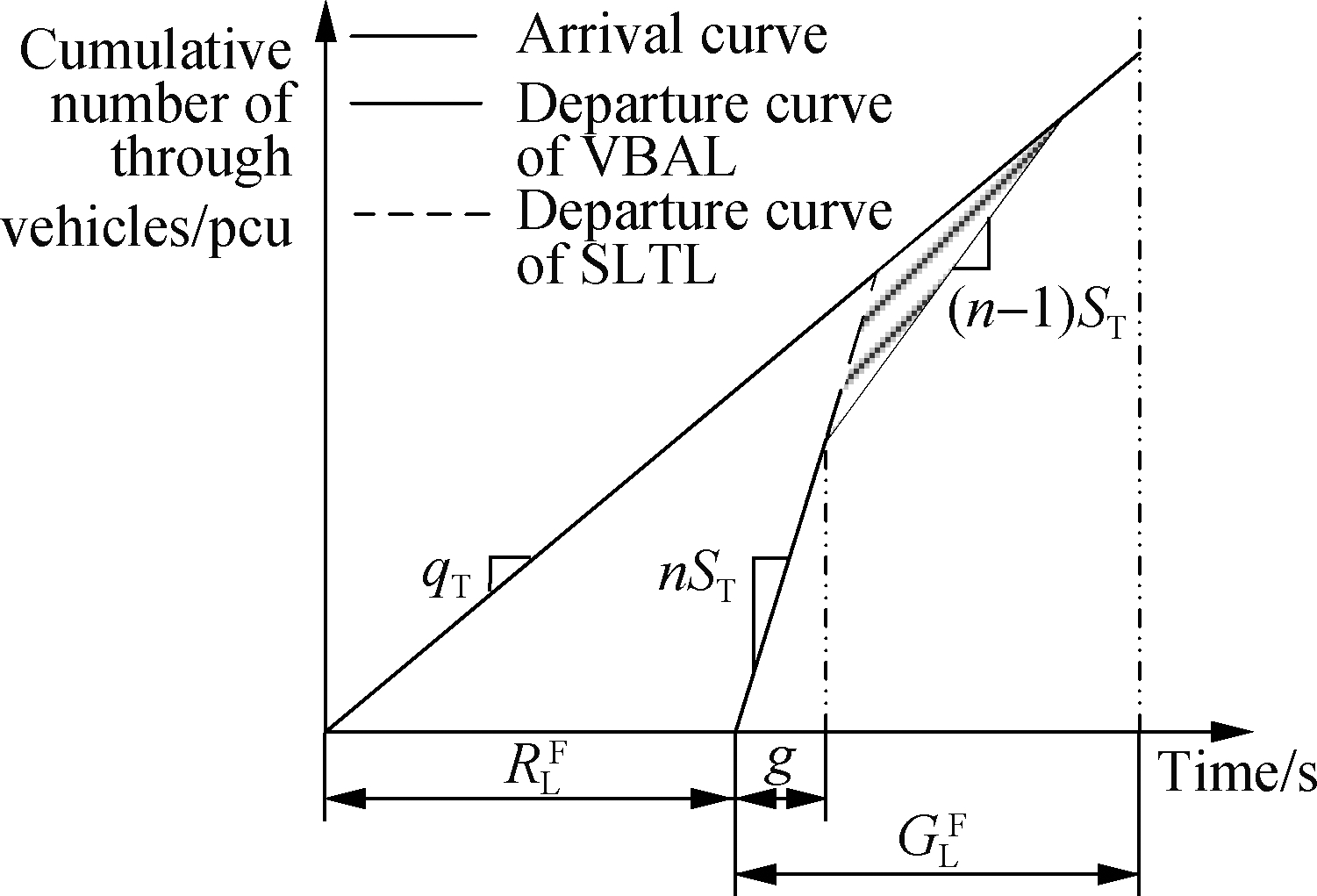
(b)
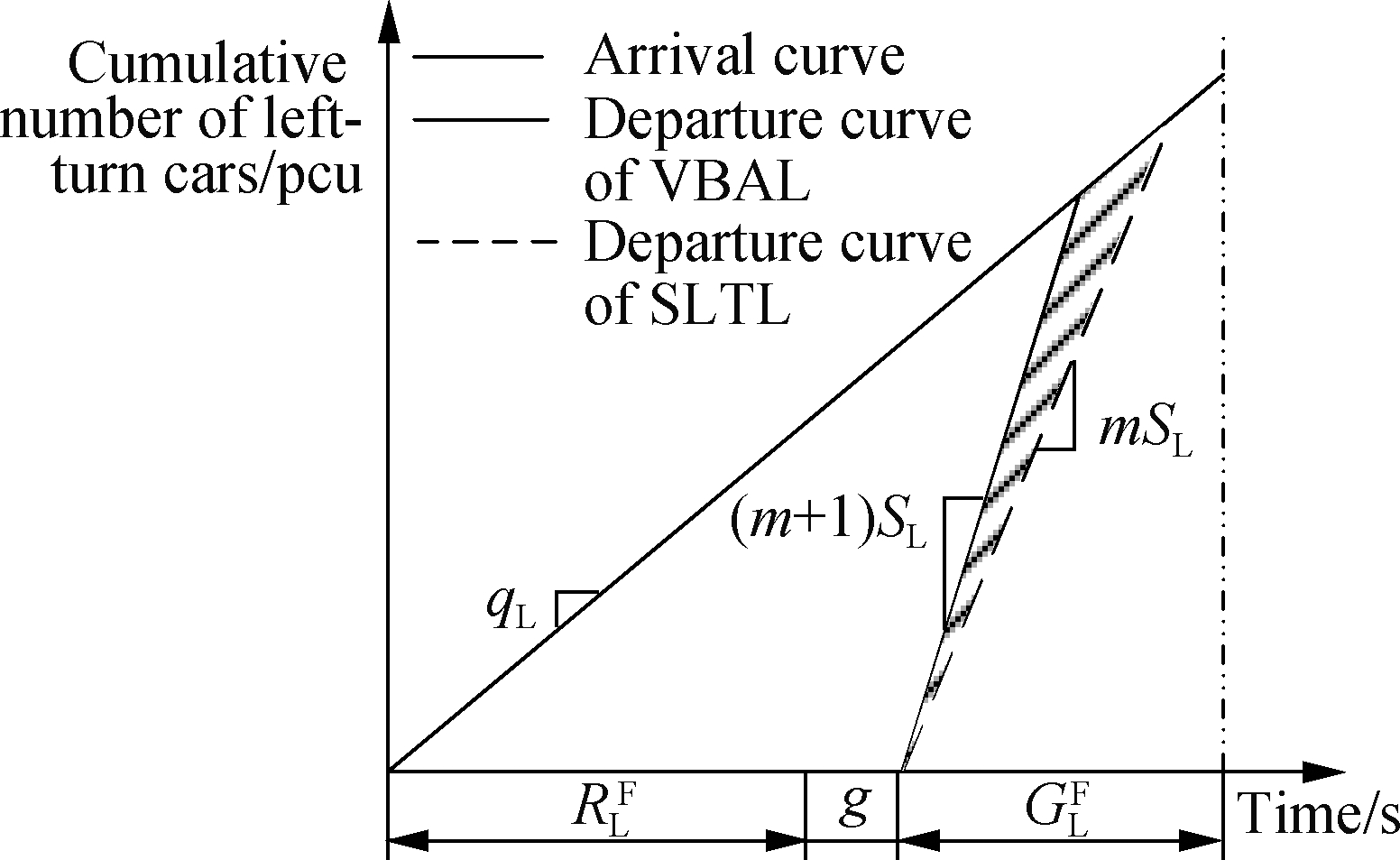
(c)
Fig.3 Comparison of delays between the VBAL and SLTL schemes.(a)Left-turning buses;(b)Through vehicles;(c)Left-turning cars
(7)

(8)
where ![]() denotes the delay reduction of left-turning buses, s; Sb(t)and SL(t)are the saturation flow rates of a bus lane and left-turn lanes, pcu/h, respectively; qb(t)is the arrival rate of left-turning buses, pcu/h;
denotes the delay reduction of left-turning buses, s; Sb(t)and SL(t)are the saturation flow rates of a bus lane and left-turn lanes, pcu/h, respectively; qb(t)is the arrival rate of left-turning buses, pcu/h; ![]() is equivalent to
is equivalent to  can be calculated as
can be calculated as
(9)
![]()
![]()
(10)
where ![]() is the increased delay of through vehicles, s; ST(t)is the saturation flow rate of the through lane, pcu/h; qT(t)the arrival rate of through vehicles, pcu/h;
is the increased delay of through vehicles, s; ST(t)is the saturation flow rate of the through lane, pcu/h; qT(t)the arrival rate of through vehicles, pcu/h;  can be given by
can be given by
(11)
![]()
![]()
(12)
where ![]() is the delay reduction of left-turning cars, s; SL(t)is the saturation flow rate of the left-turn lane, pcu/h; qL(t)is the arrival rate of left-turning cars, pcu/h,
is the delay reduction of left-turning cars, s; SL(t)is the saturation flow rate of the left-turn lane, pcu/h; qL(t)is the arrival rate of left-turning cars, pcu/h, ![]() denote the time from the beginning of a cycle to the departure time of all queuing left-turning cars, s, respectively; m is the number of left-turn lanes.
denote the time from the beginning of a cycle to the departure time of all queuing left-turning cars, s, respectively; m is the number of left-turn lanes.
Fig.4 presents the cumulative curves under the DLTL and SLTL schemes.The delay variation of left-turning buses is shown in Fig.4(a).The average delay reduction of left-turning buses under the DLTL scheme, ![]() is given by
is given by
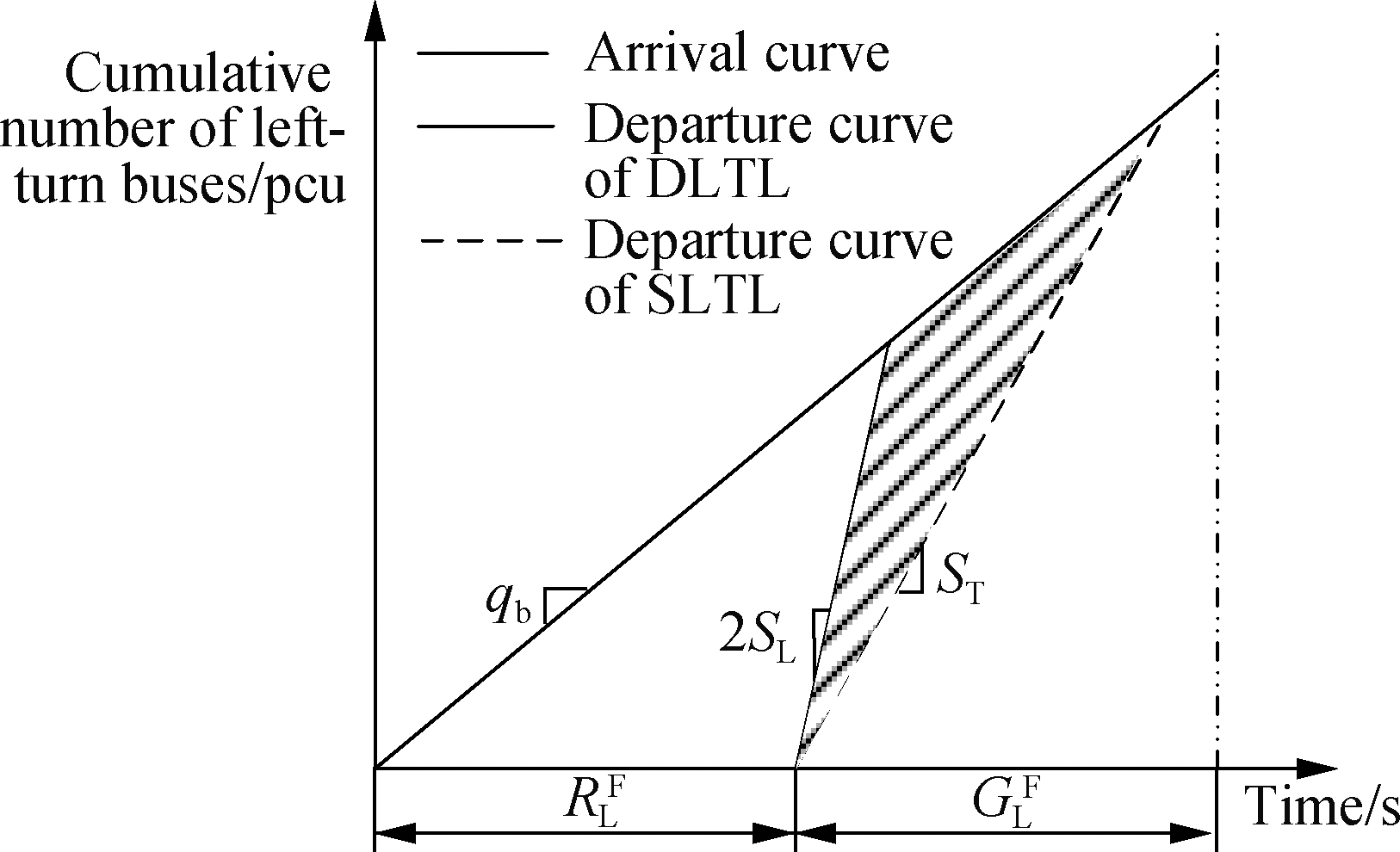
(a)
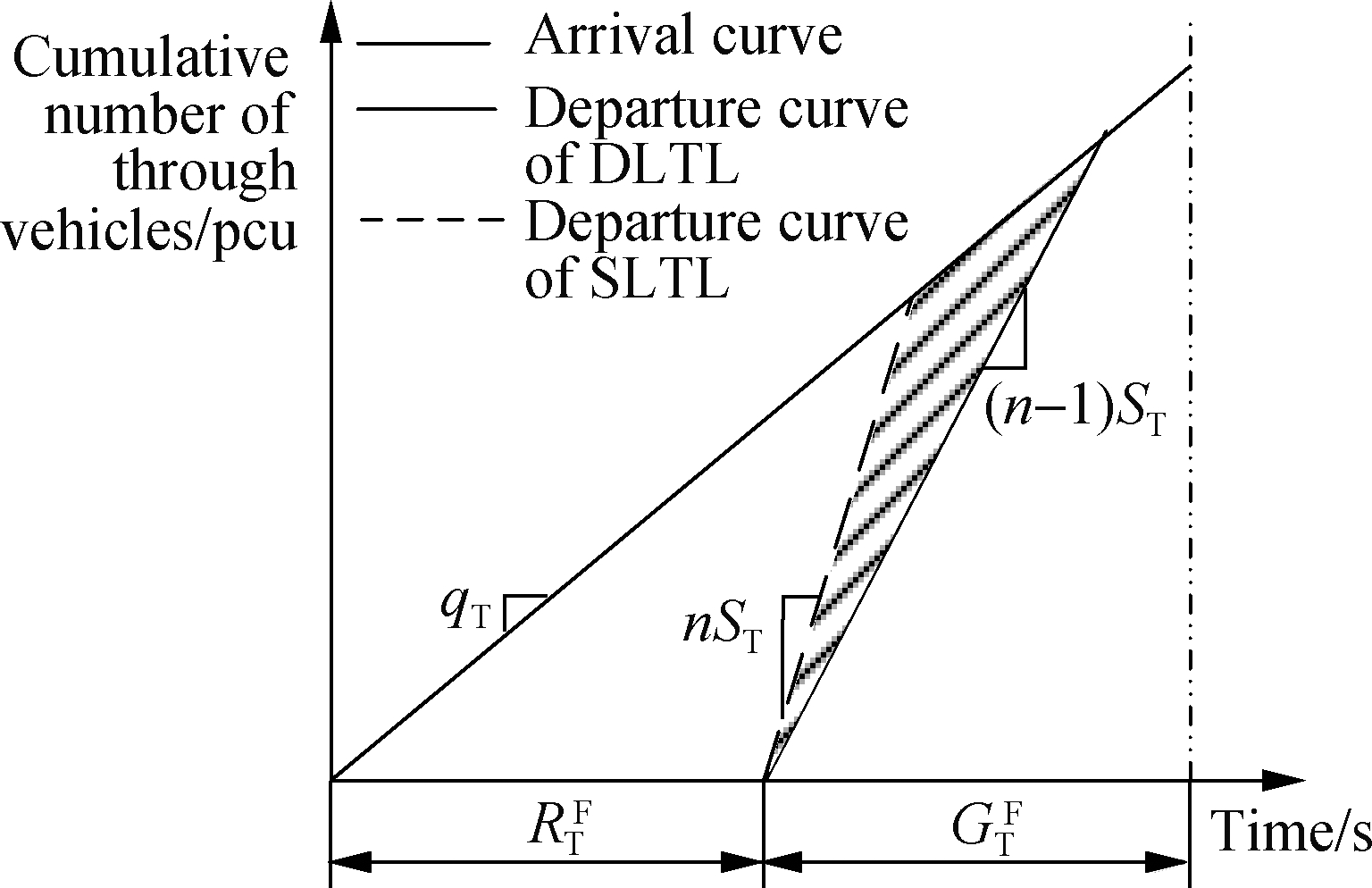
(b)
Fig.4 Comparison of delays between the DLTL and SLTL schemes.(a)Left-turning buses;(b)Through vehicles
(13)
(14)

(15)
![]()
![]()
(16)
The average variation of delays can be calculated as
(17)
(18)
where pb, pT, and pL are the proportions of left-turning buses, through vehicles, and left-turning cars arriving at the intersection in a cycle, respectively; ob and oc are the average number of passengers carried by buses and cars, respectively.
2.2 Overlapping phase
Fig.5 shows the cumulative curve of vehicles under the VBAL and SLTL schemes.As shown in Fig.5(a), the average reduction delay of left-turning buses in the VBAL, ![]() can be calculated as follows:
can be calculated as follows:
(19)

(20)
where ![]() RO is the red time of the main signal, s.r is the red time of the pre-signal when the main signal shows through green, s.
RO is the red time of the main signal, s.r is the red time of the pre-signal when the main signal shows through green, s.![]()
As shown in Fig.5(b), the delay of through vehicles is increased after the implementation of the VBAL scheme.The average increase in delay, ![]() can be given by
can be given by
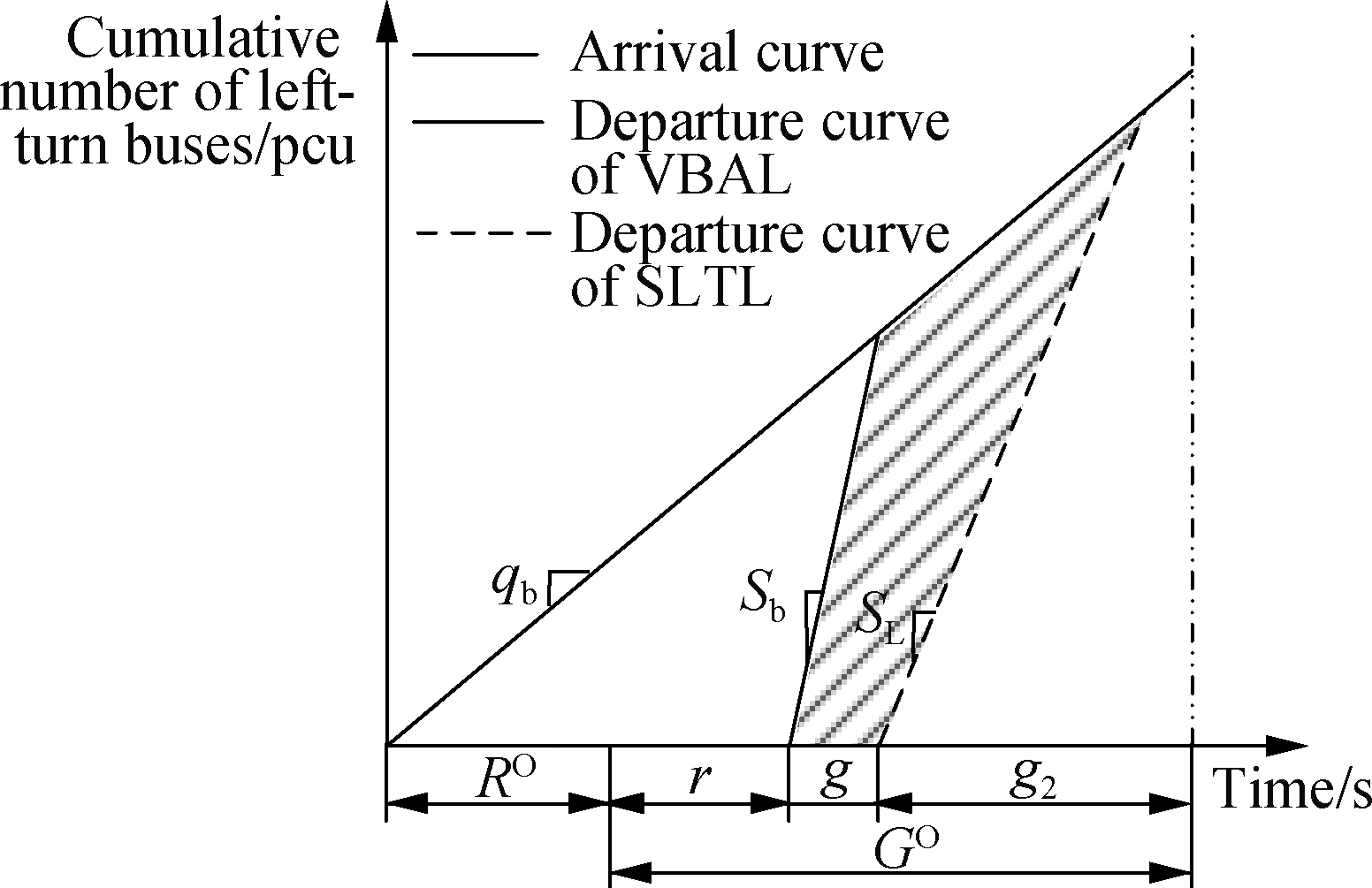
(a)
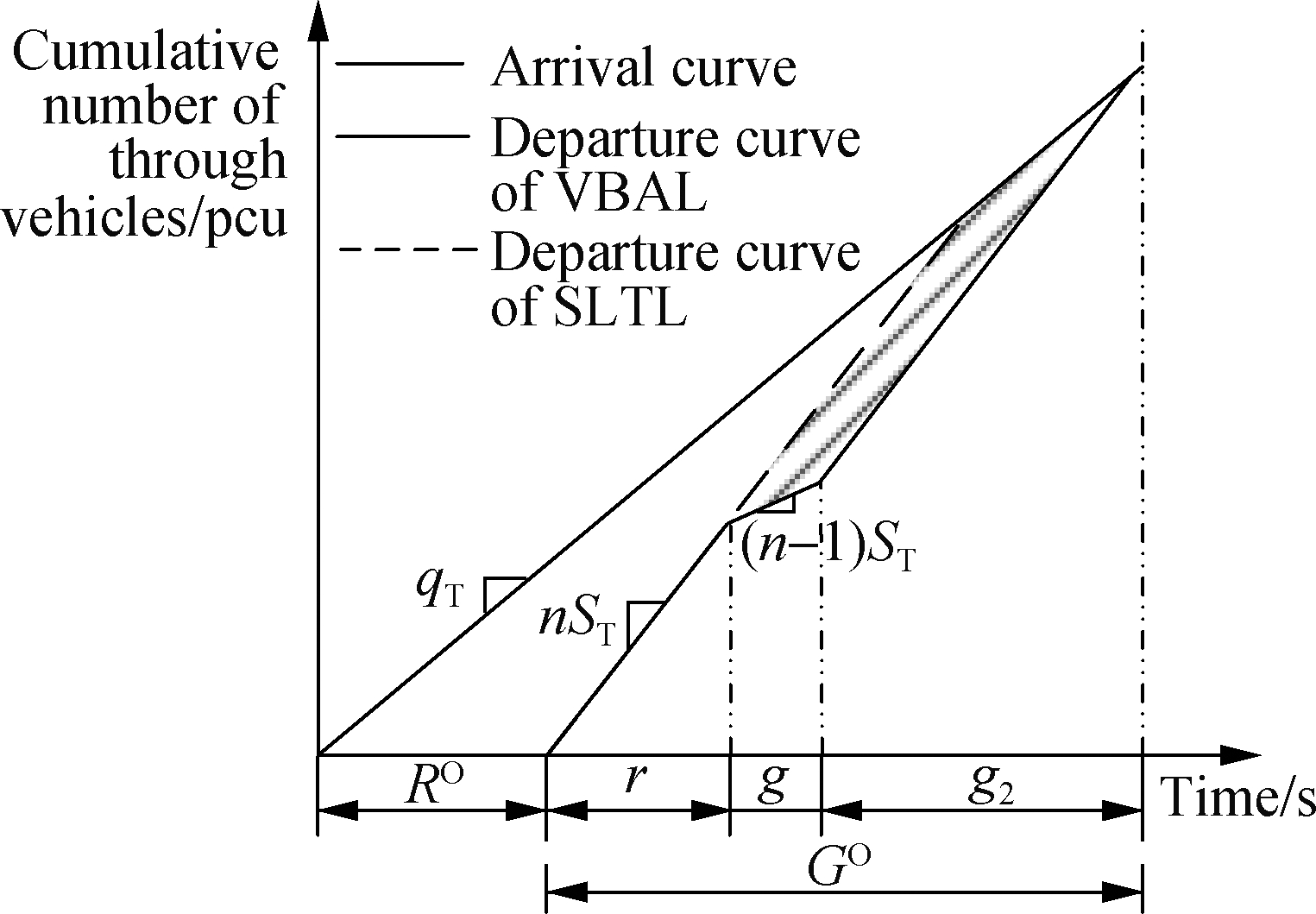
(b)
Fig.5 Comparison of delays between the VBAL and SLTL schemes.(a)Left-turning buses;(b)Through vehicles
(21)
where ![]() is the delay increase of through vehicles, s.
is the delay increase of through vehicles, s.

(22)
The cumulative curves of the DLTL and SLTL schemes are illustrated in Fig.6.As shown in Fig.6(a), the average reduction of the left-turning bus delay under the DLTL scheme, ![]() is given by
is given by
(23)
(24)
As shown in Fig.6(b), the average increase in the through-vehicle delay under the DLTL scheme, ![]() is
is

(a)
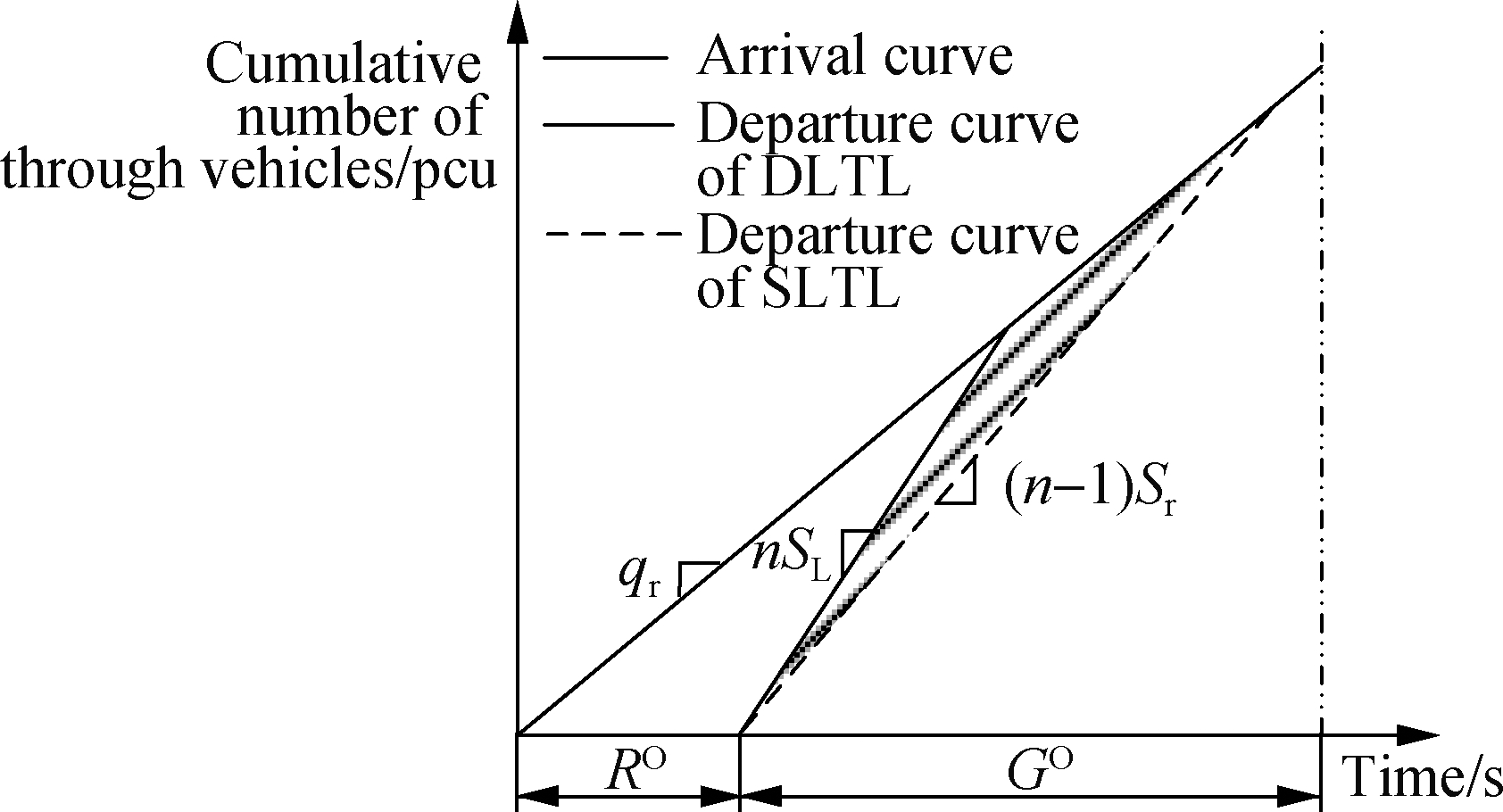
(b)
Fig.6 Comparison of delays between the DLTL and SLTL schemes.(a)Left-turning buses;(b)Through vehicles
(25)
![]()
![]()
(26)
where ![]() is the increase in delay for through vehicles, s.
is the increase in delay for through vehicles, s.
The average delay variation of the schemes can be calculated as follows:
(27)
(28)
3 Sensitivity Analysis
A sensitivity analysis was conducted using MATLAB(2017a)to analyze the impacts of the vehicle arrival rate, green split of the main signal, and proportion of vehicle types.Suppose the cycle length was 180 s.The saturation flow rates of left-turn lanes and through lanes were 0.3 and 0.6 veh/h, respectively.The saturation flow rate of left-turning bus lanes was 0.5 veh/h.The average passenger occupancy of cars and buses was 5 and 40 per/veh, respectively.The advance time of pre-signal was 9 s.
As shown in Fig.7(a), the delay reduction of left-turning buses in the VBAL scheme is larger than that in the DLTL scheme.Moreover, the VBAL scheme with an overlapping phase has the largest reduction of left-turning bus delay.The greater the arrival rate of left-turning buses, the greater the delay reduction.As shown in Fig.7(b), with the increase in green split, the reduction in the left-turning-bus delay gradually decreases.In the two phases, the reduction in the left-turning-bus delay in the VBAL is greater than that in the DLTL.
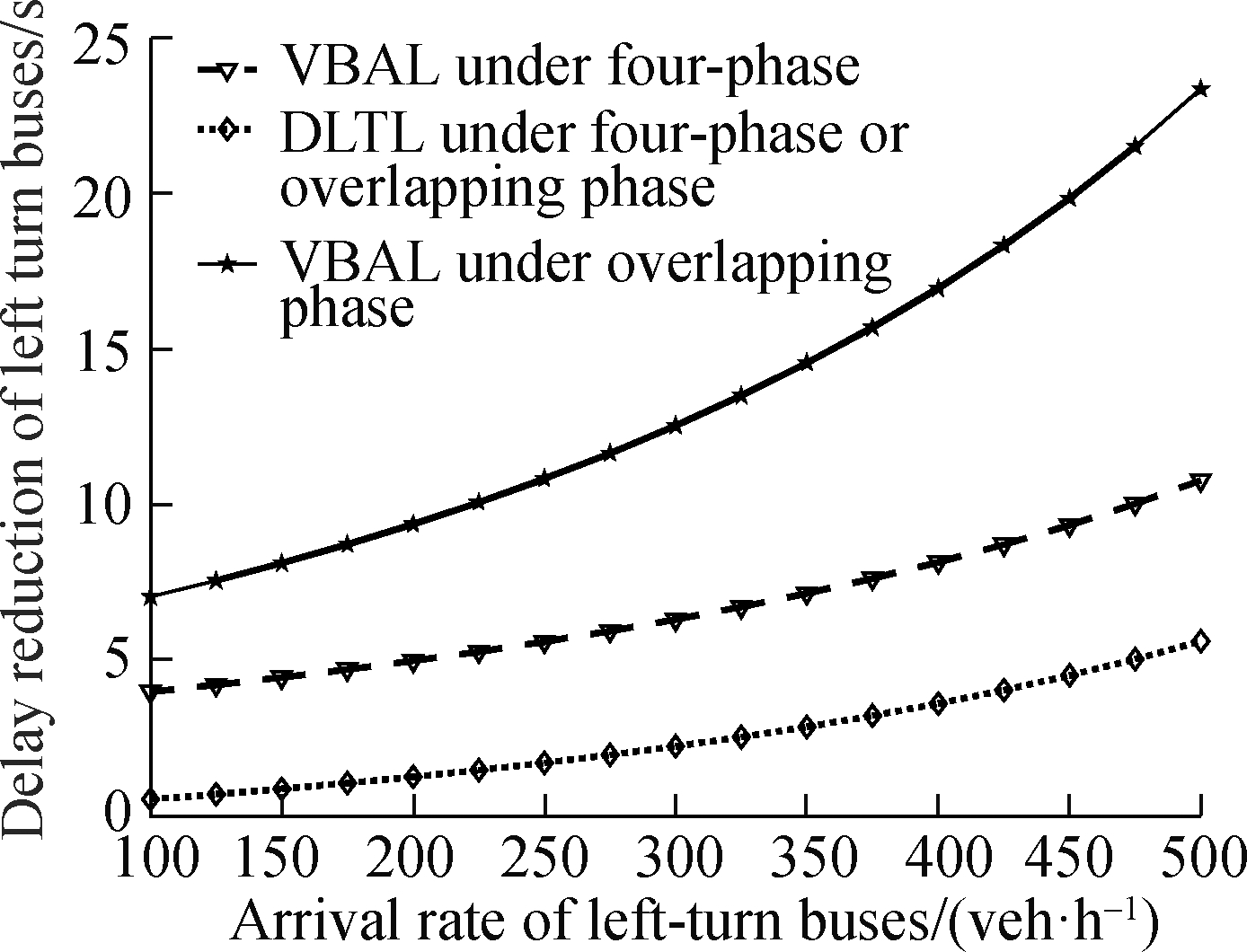
(a)
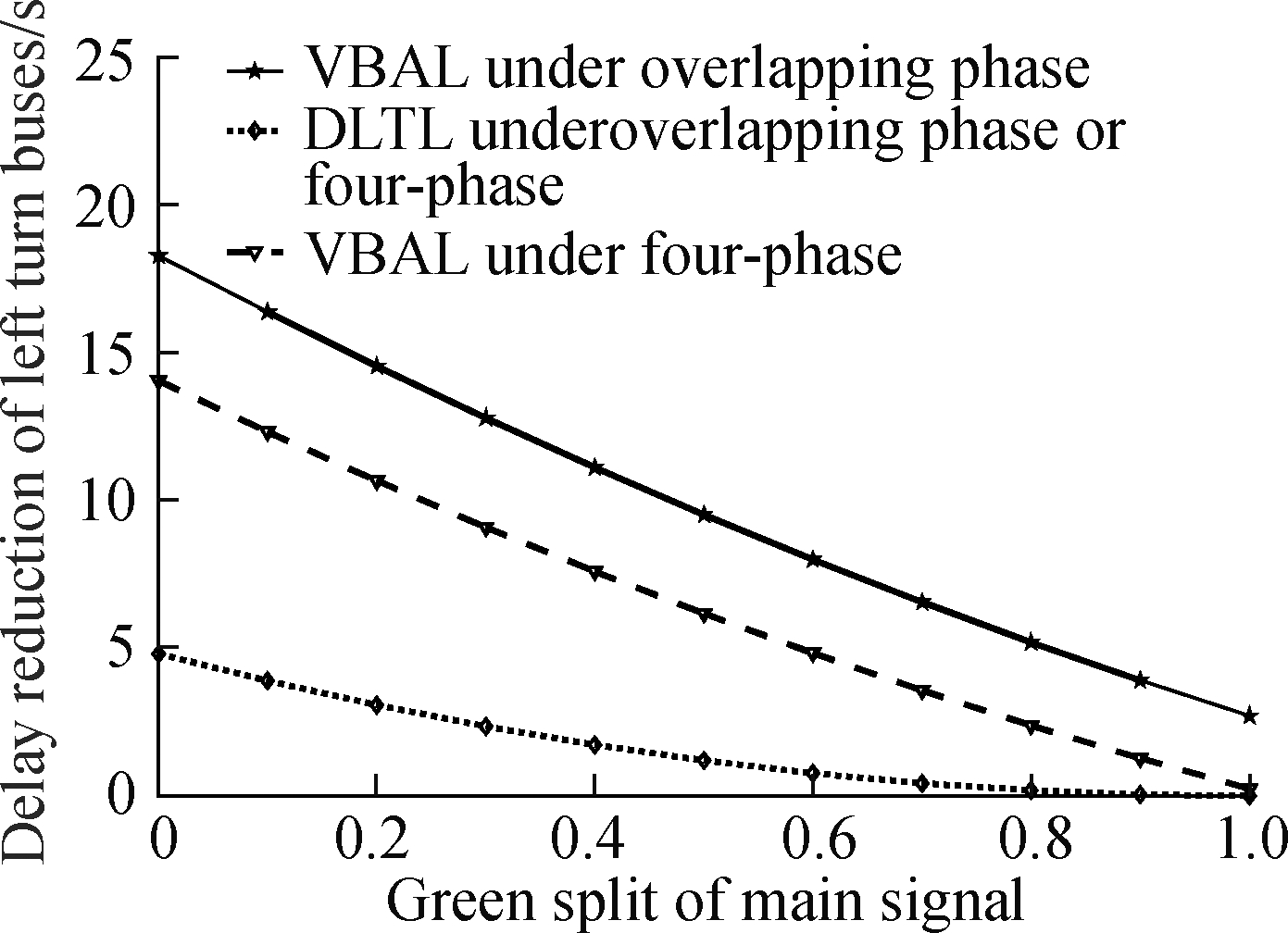
(b)
Fig.7 Delay reduction of left-turning buses under different parameters.(a)Arrival rate;(b)Green split of main signals
As shown in Fig.8(a), the delay increase of the VBAL scheme is the lowest under the overlapping phase, and the curve of the increase in delay tends to be flat with the increase in the arrival rate of through vehicles.While the arrival rate of through vehicles reaches approximately 3 000 veh/h, the increase in delay would significantly increase.As shown in Fig.8(b), the increase in delay under the VBAL scheme is lower than that in the DLTL scheme.Clearly, the curve of the VBAL scheme gently changes around 0, which proves the implementation advantage of the VBAL scheme again.
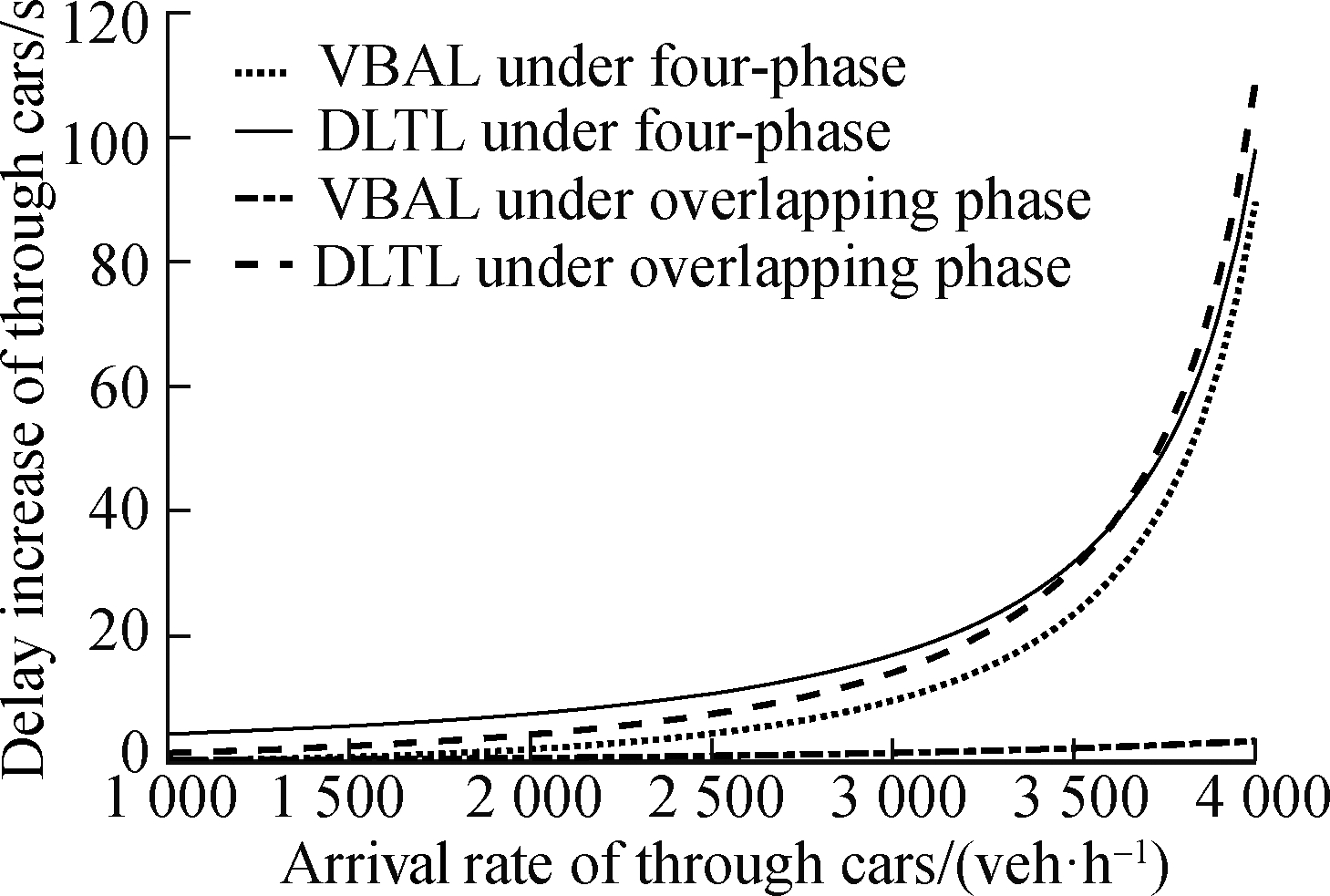
(a)
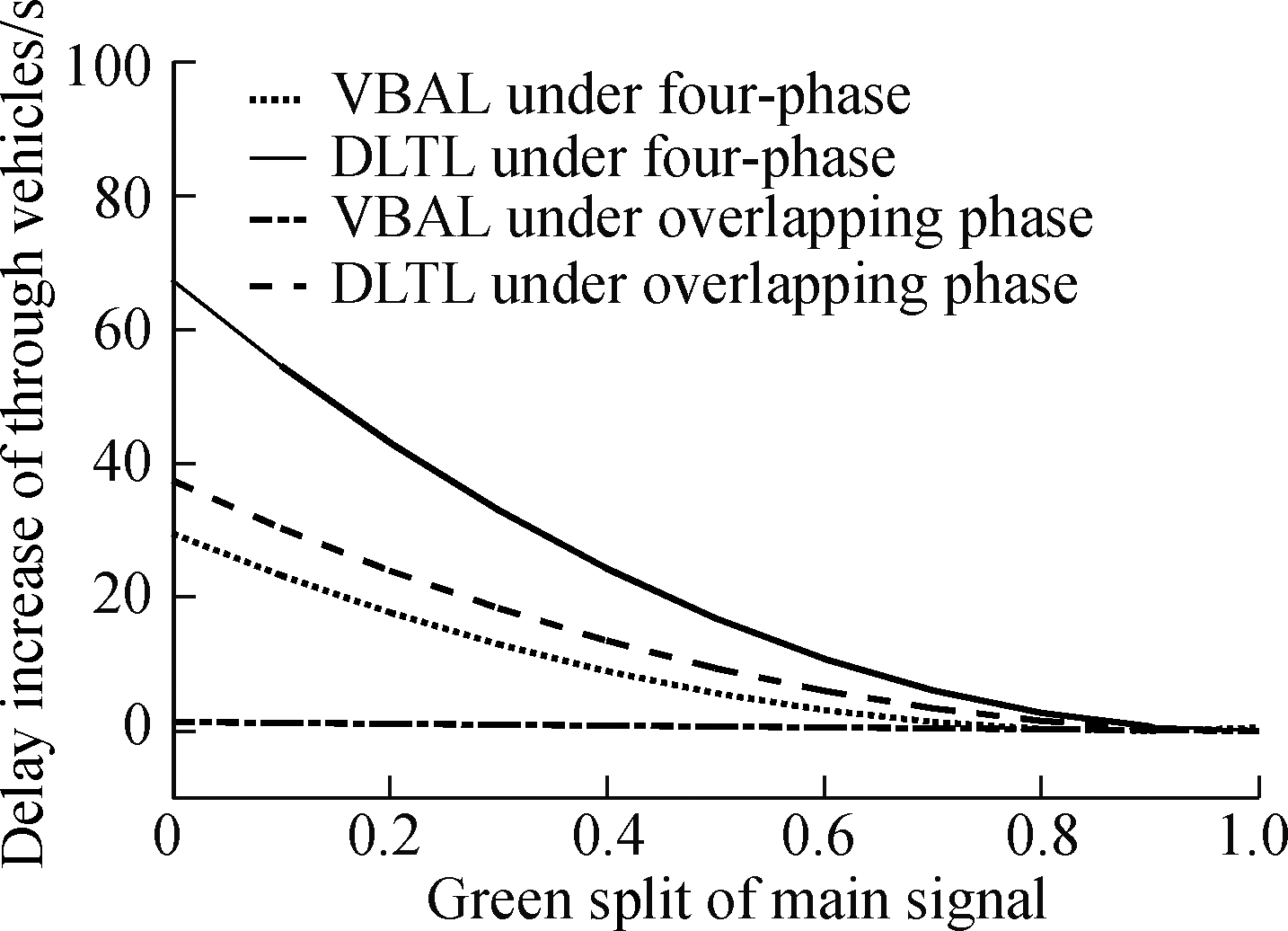
(b)
Fig.8 Delay increase of through vehicles under different parameters.(a)Arrival rate;(b)Green split of the main signal
As shown in Fig.9(a), the greater the proportion of left-turning buses, the greater the reduction of delay on the approach road.The DLTL scheme under the overlapping phase is not suitable for intersections because although its delay shows a downward trend, the variation of delay is always positive.In the other three schemes, the VBAL scheme with an overlapping phase has the largest delay reduction.As shown in Fig.9(b), it has the opposite tendency as compared to that in Fig.9(a).The VBAL scheme with an overlapping phase has the largest delay reduction.

(a)
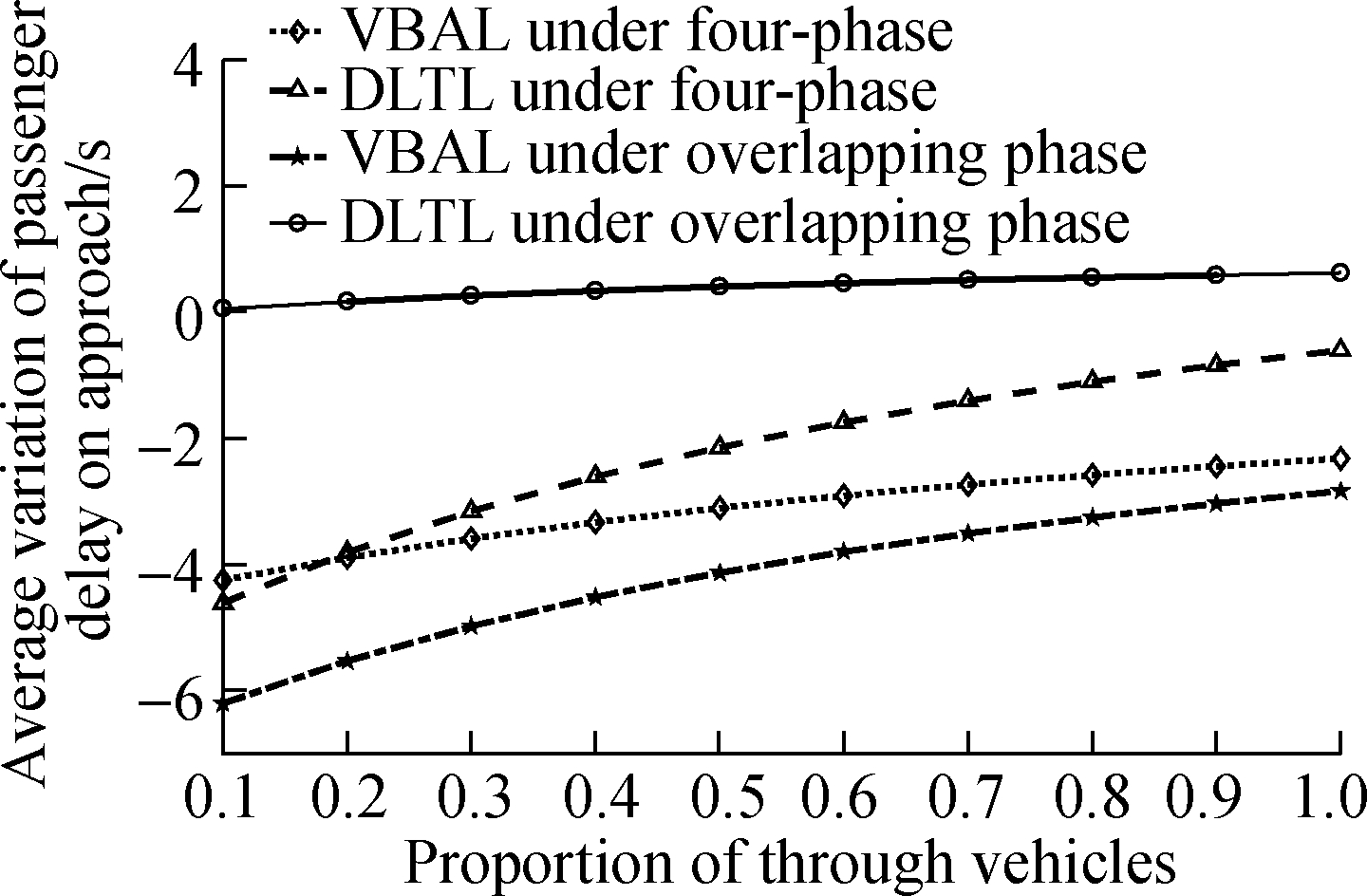
(b)
Fig.9 Average variation of passenger delay on the approach under different proportions.(a)Left-turning buses;(b)Through vehicles
4 Case Study
The effectiveness of the three schemes was evaluated at an intersection, i.e., the Furong-Xinyao Road located in Changsha.The traffic volume during the peak period is shown in Tab.2.The overlapping phase was adopted inthe north approach.Hence, the north approach was selected to evaluate the three schemes.Meanwhile, the signal timing of the VBAL scheme was obtained based on Eqs.(1)and(2), as shown in Fig.10.According to Eqs.(3)to(6), l3 and l2 are 32 and 14 m, respectively.
Tab.2 Traffic flow at the intersection
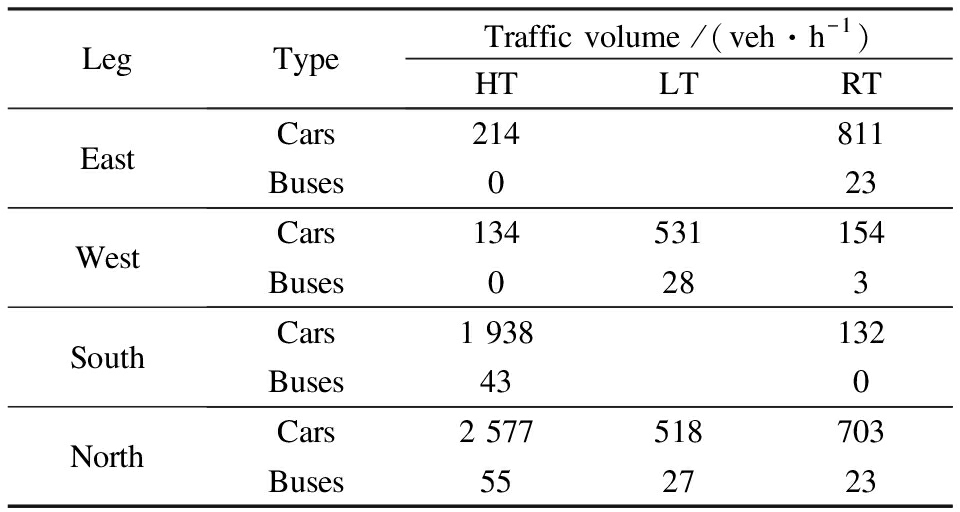
LegTypeTraffic volume /(veh·h-1)HTLTRTEastCars214811Buses023WestCars134531154Buses0283SouthCars1 938132Buses430NorthCars2 577518703Buses552723
Note: LT, HT, and RT refer to the left-turn, through, and right-turn movements, respectively.

(a)
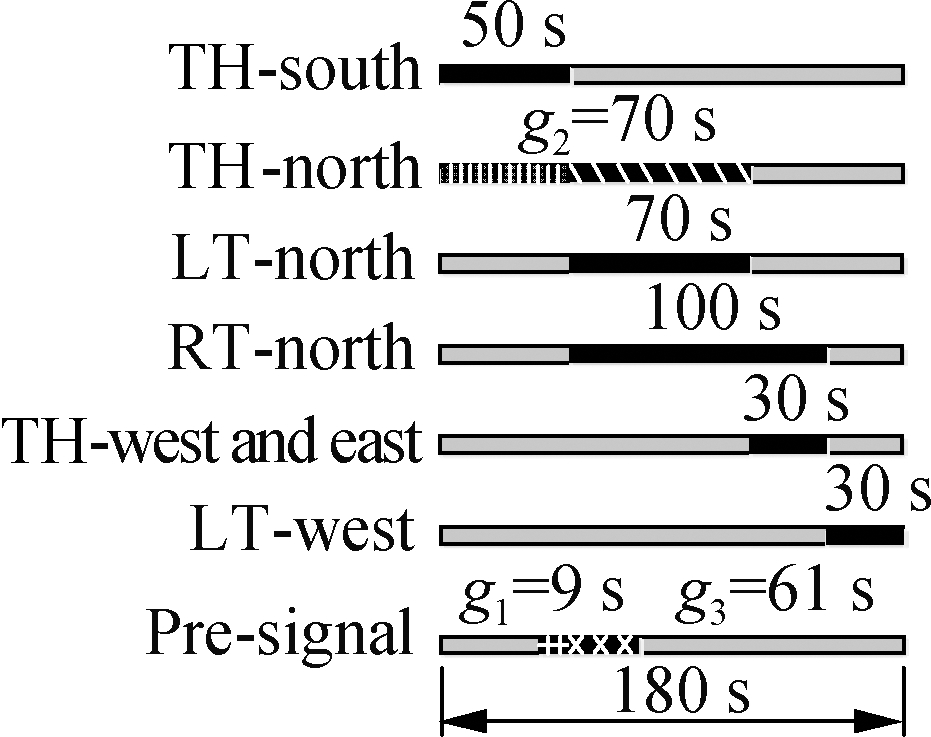
(b)
Fig.10 Signal timing.(a)Before optimization(b)After optimization
We inputted the above data into the delay model, and the results are shown in Tab.3.In the VBAL scheme, the delay of left-turning buses decreased by 5.56 s, whereas in the DLTL scheme, it only decreased by 0.05 s.For through vehicles, the delay of the DLTL and VBAL schemes increased by 8.2 and 0.85 s, respectively.Hence, the VBAL scheme can effectively reduce the delay of left-turning buses and minimize the increase in through-vehicle delay.
Tab.3 Comparison of the average variations

SchemesVehicle typeDelay variation/sVBALLT buses-5.56HT vehicles0.85DLTLLT buses-0.05HT vehicles8.20
To further verify the applicability of the method, VISSIM11.0 was used to simulate the three schemes.As shown in Tab.4, the delay reduction of left-turning buses is lower under the DLTL scheme than that under the VBAL scheme, whereas the delay of through vehicles was significantly increased.The queue length of the left-turn lane in the VBAL scheme was less than that of the DLTL scheme, but the queue length of through vehicles was slightly increased.Hence, the VBAL scheme is more suitable than the DLTL scheme.
Tab.4 Simulation results of each scheme
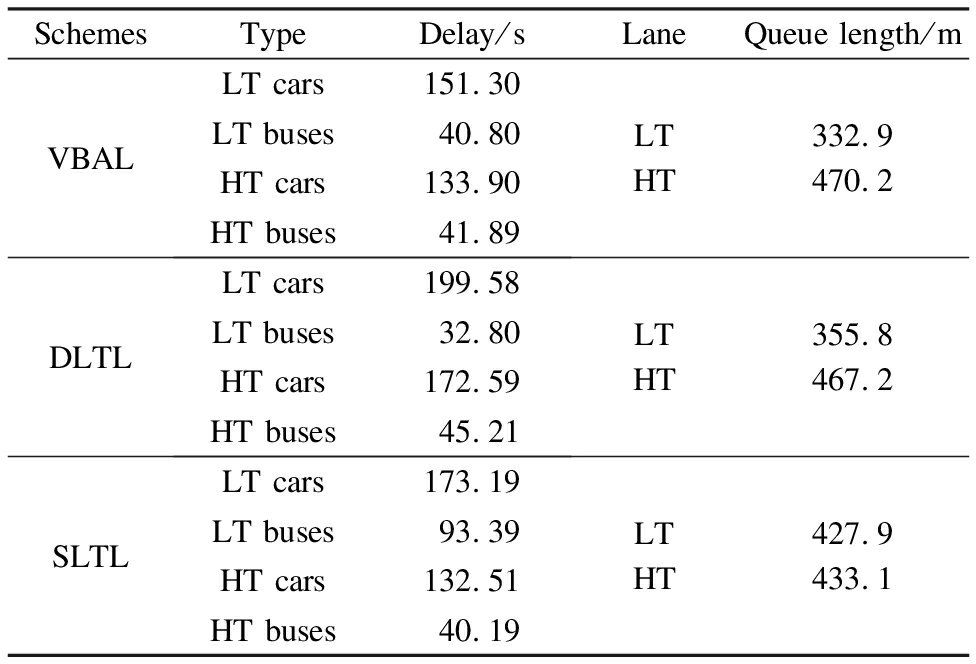
SchemesTypeDelay/sLaneQueue length/mVBALLT cars151.30LT buses40.80HT cars133.90HT buses41.89LTHT332.9470.2DLTLLT cars199.58LT buses32.80HT cars172.59HT buses45.21LTHT355.8467.2SLTLLT cars173.19LT buses93.39HT cars132.51HT buses40.19LTHT427.9433.1
5 Conclusions
1)This paper presents a novel left-turning bus priority method called VBAL.Under this method, left-turning buses are provided with priorities by combining a variable lane and local pre-signal.Accordingly, the increase in through-vehicle delay can be minimized.
2)As an evaluation method, a cumulative curve was used to establish a delay calculation model.On this basis, the VBAL, DLTL, and SLTL schemes were compared through sensitivity analyses and case studies, and the results validated the feasibility of the VBAL scheme.
3)In the real world, variable areas are crowded with other vehicles, and a through vehicle getting stuck in a VBAL would occur.These problems need the implementation of electronic signs, movable guardrails, and other traffic facilities.
[1] Zhao J, Ma W J.Optimizing vehicle and pedestrian trade-off using signal timing in intersections with center transit lanes[J].Journal of Transportation Engineering, Part A: Systems, 2018, 144(6): 04018023.DOI:10.1061/jtepbs.0000145.
[2] Shu S J, Zhao J, Han Y.Novel design method for bus approach lanes with bus guidance and priority controls for prioritizing through and left-turn buses[J].Journal of Advanced Transportation, 2019, 2019: 2327876.DOI:10.1155/2019/2327876.
[3] Viegas J, Lu B C.The intermittent bus lane signals setting within an area[J].Transportation Research Part C: Emerging Technologies, 2004, 12(6): 453-469.DOI:10.1016/j.trc.2004.07.005.
[4] Eichler M, Daganzo C F.Bus lanes with intermittent priority: Strategy formulae and an evaluation[J].Transportation Research Part B: Methodological, 2006, 40(9): 731-744.DOI:10.1016/j.trb.2005.10.001.
[5] He H T,Guler S I, Menendez M.Adaptive control algorithm to provide bus priority with a pre-signal[J].Transportation Research Part C: Emerging Technologies, 2016, 64: 28-44.DOI:10.1016/j.trc.2016.01.009.
[6] Bhattacharyya K,Maitra B, Boltze M.Guidance for design and implementation of queue jump lane with presignal for a heterogeneous traffic environment[J].Journal of Transportation Engineering, Part A: Systems, 2020, 146(10): 04020111.DOI:10.1061/jtepbs.0000441.
[7] Khwais M, Haddad J.Optimal pre-signal control for buses and cars at isolated signalized intersections[J].IFAC-Papers OnLine, 2017, 50(1): 9706-9711.DOI:10.1016/j.ifacol.2017.08.2053.
[8] Ghanbarikarekani M, Qu X B, Zeibots M, et al.Minimizing the average delay at intersections via presignals and speed control[J].Journal of Advanced Transportation, 2018, 2018: 4121582.DOI:10.1155/2018/4121582.
[9] Liang Y Y, Wu Z Z, Li J Y, et al.Shockwave-based queue length estimation method for presignals for bus priority[J].Journal of Transportation Engineering, Part A: Systems, 2018, 144(9): 04018057.DOI:10.1061/jtepbs.0000175.
[10] Zhao J, Zhou X Z.Improving the operational efficiency of buses with dynamic use of exclusive bus lane at isolated intersections[J].IEEE Transactions on Intelligent Transportation Systems, 2019, 20(2): 642-653.DOI:10.1109/TITS.2018.2819243.
[11] Liu P, Wu J M, Zhou H G, et al.Estimating queue length for contraflow left-turn lane design at signalized intersections[J].Journal of Transportation Engineering, Part A: Systems, 2019, 145(6): 04019020.DOI:10.1061/jtepbs.0000240.
[12] Wu H.Research on vehicle lane changing control based on the minimum safety distance[D].Harbin: Harbin Institute of Technology, 2015.